Your quad is a do-anything machine. ATV’s are great for getting things done and for recreation too. But now you’re looking at your tires. Maybe you’ve blown one or they’re getting bald. Or maybe you just want a more aggressive tread pattern and a bigger tire. The problem is you’re a little lost when it comes to your ATV tire size.
How big can you go? Should you go big? How do you even know what all these numbers represent?
Don’t worry, we’ve got you covered. We’ll answer all those answers and more in this comprehensive guide.
How Do You Read ATV Tire Sizes?So, you’re shopping around for tires and you see one listed with a size like 26×10-12. Or, worse yet, you find something listed like 206/80R12.
What the heck does all that mean?
First, you need to figure out if you’re dealing with standard or metric ATV tire sizes.
ATV Tire Sizes: Standard Tire Sizing ChartStandard format is much more common on ATV tires than metric. You might see a tire size written 26×10-12 or, occasionally, 26x10x12. This format is pretty straightforward. It uses three numbers to sum up the size:
If you see a tire size that looks like this: 205/80R12, you know you’re dealing with metric. The metric format is exceedingly rare for ATVs and odds are you’ll never come across it. But if you do, the letter thrown in the middle of those numbers is a dead giveaway. In metric, you always have three numbers and a letter:
There may be other numbers and letters before and after these, but they’re not important for understanding your ATV tire size.
Breaking Down ATV Tire Sizes by the NumbersKnowing how to read those tire sizes is just the first step.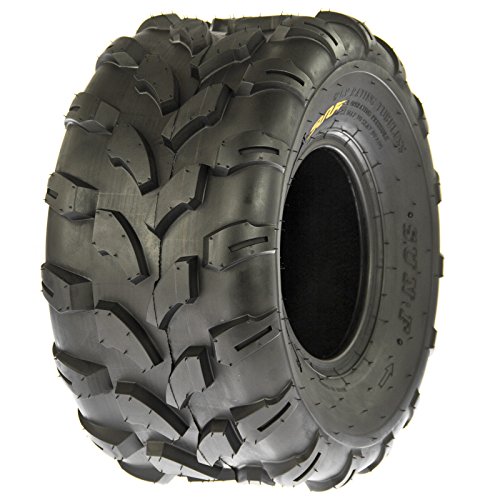 You really need to know how to use them. Is 26 inches a reasonable diameter for your quad? What kind of width do you need?
You really need to know how to use them. Is 26 inches a reasonable diameter for your quad? What kind of width do you need?
When you’re considering replacing all of your tires, you’ll want to make sure you get something that will actually fit on your stock vehicle.
Your typical ATV tire diameter fits within a range of about 20 inches for the smallest machines to about 30 inches for your more factory mud-equipped machines.
Basically, your quad will typically fit into one of few categories:
Keep in mind that you’ll want to keep within a couple inches of your stock tire size. If you go too big, you’ll start to rub on your fenders (among other issues). If you go small—well, that’s just silly.
Tire width is easier to understand. Choosing the right tire width has a lot to do with your own preferences and riding style.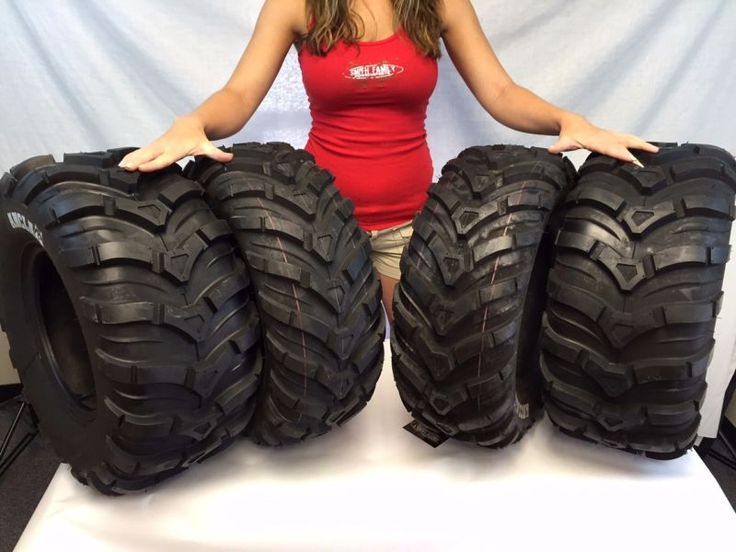
A wider tire tends to give you a flatter tread pattern and more grip. A narrow tire gives you a little more control.
ATV’s usually have a wider tire on the rear than on the front to get the best of both tires. A typical rear tire on a quad will be 10 to 11 inches wide while a front tire will be 7 to 8 inches wide.
But matching your tire width to your riding style isn’t the only thing you need to consider. You also need to make sure it’ll physically fit on your chosen wheel. There are two main ways to make sure it’ll fit.
This one is non-negotiable.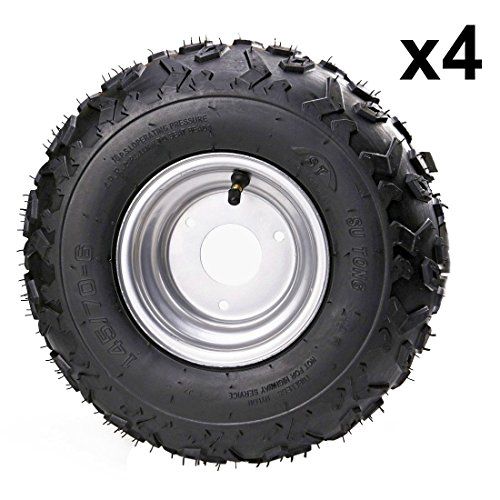 You have to make sure your tire’s wheel diameter matches your actual wheel diameter.
You have to make sure your tire’s wheel diameter matches your actual wheel diameter.
Most off-road wheels tend to be 10 to 12 inches in diameter—which is convenient considering most off-road tires are designed to fit those wheels. That’s a good size as it gives your tire plenty of cushion between the tread and rim, which results in smoother rides and more protection for your rims.
Of course, you can end up with bigger wheels if you have bigger tires, but we’re getting ahead of ourselves.
Choosing the Right Size Tires for Your ATVYou don’t need any old tire. You have to choose the perfect ATV tire size for you. After all, you ride your own way and have your own needs.
We’re going to simplify ride style to three main types:
For a workhorse ATV, it’s not a bad idea to stick with stock. It’ll give you the expected traction and power you need.
Trail riding, like dune riding, means you want to go fast. For that, a wider, flatter tire will keep you gripping and in control. If you ride in the mud, you might want to go with something bigger and narrower along with an aggressive tread pattern.
For that, a wider, flatter tire will keep you gripping and in control. If you ride in the mud, you might want to go with something bigger and narrower along with an aggressive tread pattern.Trails and dunes demand high traction, and you get that by going wider. You don’t necessarily need a taller tire, but a wider one will give you the grip you need.
Dominating rock gardens and taking on bounty holes is done best with a big tire. But going big isn’t as simple as just buying the biggest tire you see.
Can I Put Bigger Tires on My ATV?The short answer is yes.
Here comes the long answer.
Every ATV has a theoretical maximum tire size it can fit without modifying the suspension. It’s typically about one to two inches bigger than your stock tires. So if your ATV came with a 27-inch tire, you could probably fit a 29-inch tire without too much trouble.
But what if you want to go bigger?
That takes some work. You’ll either need to invest in a lift kit or some offset A-arms. These types of kits will often tell you what the max tire size is when you have them installed.
These types of kits will often tell you what the max tire size is when you have them installed.
You can’t go big without some consequences though. Namely, you’ll lose torque due to the increased diameter (big tires like a high-gear kit!) and the extra weight. The weight can also put extra strain on your clutch and shorten the life of your clutch belt.
Luckily, you can get your torque back with a transmission gear reduction or GDP Portal Gear Lift (which has a gear reduction built in).
You can also bolster your clutch with heavy-duty drive belts and eek out even more torque with a clutch kit.
So now that you’re equipped with knowledge, go equip yourself with some tires. Get the ATV tire size you want, and ride with confidence.
RELATED CONTENT: ATVs37 tires15
Share
10
ATV tire explaination: ATV tires are listed in a set of three numbers, generally separated by dashes (25-10-12), or by an ‘x’ (25x10x12) or a combination of the two: 1st Number = The overall tire height when inflated (Ex.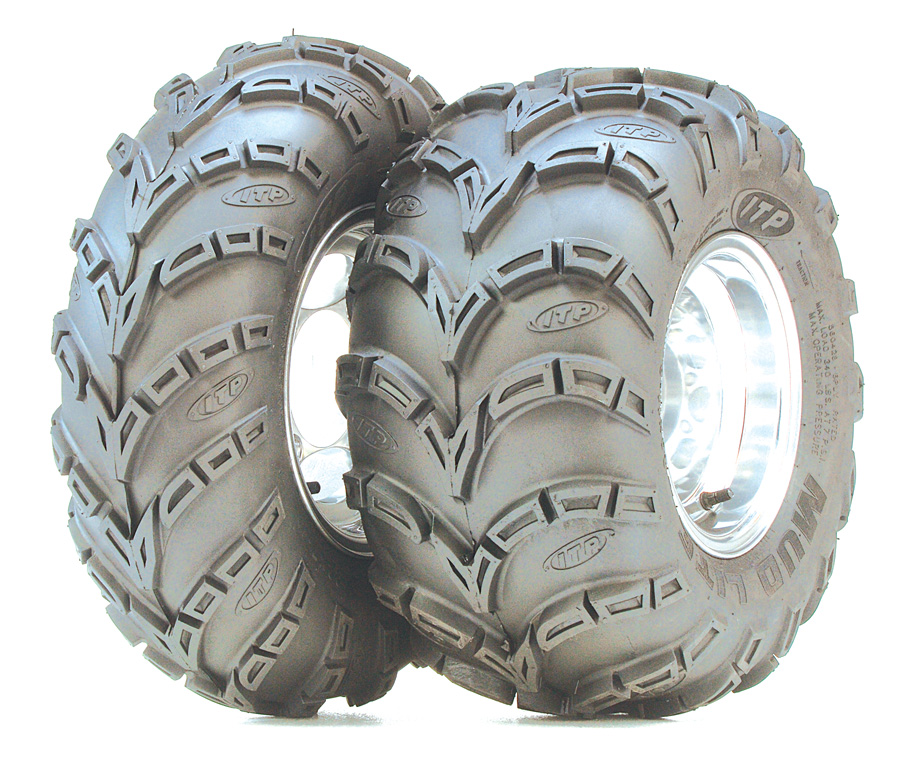 3rd Number = The rim or wheel diameter (Ex. 25×10-12 is 12″ in diameter).
3rd Number = The rim or wheel diameter (Ex. 25×10-12 is 12″ in diameter).
All ATV Tire sizes consist of 3 sets of numbers generally separated by dashes (ex. 25-8-12), forward slashes (ex. 25/8/12), or with an x (ex. 25x8x12). 1st Number = The overall height of the tire. (ex. 25×8-12 tire is 25″ tall.)
What do the numbers mean for an ATV tire size? Understanding ATV tire sizes. Inch size is the most widely used measurement in ATV tires. In the size 25 8.00-12, the meaning of the numbers is as follows: 25 – The overall height of the tire when mounted and inflated. 8.00 – The overall width of the tire when mounted and inflated. 12 – The diameter of the wheel this tire will mount to.
How do you size an ATV tire? Shown here is an example of ATV tire sizing. All ATV Tire sizes consist of 3 sets of numbers generally separated by dashes (ex. 25-8-12), forward slashes (ex. 25/8/12), or with an x (ex. 25x8x12). 1st Number = The overall height of the tire. (ex. 25×8-12 tire is 25″ tall. ) 2nd Number = The overall width of the tire. 3rd Number = The rim diameter.
) 2nd Number = The overall width of the tire. 3rd Number = The rim diameter.
What does the are mean on an ATV tire? This tells you the diameter of the rim for the tire on your ATV. In the example, “26X10-12,” the rim size is 12. Some numbers on ATV tires will have an “R” between the second and third number. The “R” simply means radial construction.
What is the width of an ATV tire? Notice the second number in the series of three. This number corresponds to the width of the tire or how fat the tire measures. In our example, “26X10-12,” the width of the ATV tire is 10 inches. Find the third number.
Table of Contents
355/40R22 tires have a diameter of 33.2″, a section width of 14.0″, and a wheel diameter of 22″. The circumference is 104.2″ and they have 608 revolutions per mile. Generally they are approved to be mounted on 12-14″ wide wheels.
Tire Width Is the width of the tire measured in millimeters from sidewall to sidewall. The first three-digit number in the tire size refers to the tire width. For instance, in a size P215/65 R15 tire, the width is 215 millimeters.
The first three-digit number in the tire size refers to the tire width. For instance, in a size P215/65 R15 tire, the width is 215 millimeters.
33″ Tires (+/- 0.50″ in overall diameter)
—————————————–
15″
33X950-15
33X10.50-15
33X11.50-15
Metric Standard
——— ———–
375/50/18 33.0″x 15.4
325/60/18 33.2″x 13.3
325/65/18 34.8″x 13.5
305/70/18 35.0″x 12.2
33-inch tires work well with rims that measure 15 or 16 inches in width, while 35-inch tires should only be used with rims that are at least 17-inches wide.
The current tire on my quad is a 22x11x10. The smallest size these tires have is the 22x12x10. 22 = The overall height of the tire when mounted and inflated to recommended air pressure. In this example, the tire is 22 inches tall. 12 = The overall width of the tire when mounted and inflated to recommended air pressure.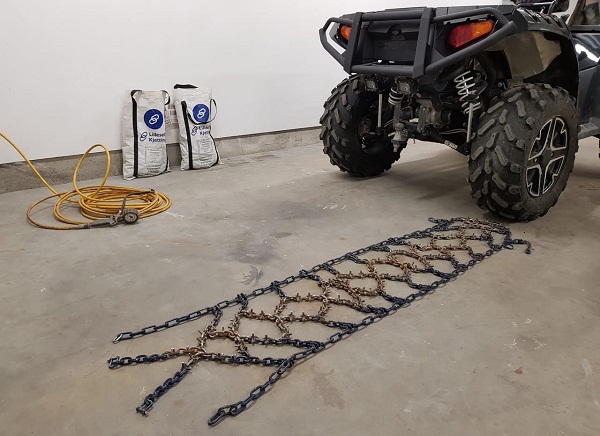
25×11-12. The ATV tires within this category are all available in the selected size; 25×11-12. The numbers 25-11-12 represent the dimensions of the tire. The first number is the height, the second number is the width & the third number is the diameter of rim that it will fit on.
50-18 is a 305/60-18 metric size. Other close sizes are 325/60-18 (33×13. 00) and 305/65-18 (34×12.
This number indicates that your tire has a width of 265 millimeters. 70. This number means that your tire has an aspect ratio of 70%. In other words, your tire’s sidewall height (from the edge of the rim to the tire’s tread) is 70% of the width.
Rim Size P-Metric Size
——— ————-
16 Inch 285/75R16
305/70R16 32.8 inches
315/75R16 34.6 inches
345/75R16 36.4 inches
B: TIRE WIDTH The three-digit number following the letter is the tire’s width (from side to side, looking at the tire head on) in millimeters. It’s the height of the sidewall measured from wheel rim to top of the tread, expressed as a percentage of tire width. In other words, it’s sidewall height divided by tire width.
It’s the height of the sidewall measured from wheel rim to top of the tread, expressed as a percentage of tire width. In other words, it’s sidewall height divided by tire width.
A 305/70/16 is a 32.8 (~33) by 12.00 inch tire.
Obviously, you will need a certain kind of tire depending on how you use your vehicle. Due to this, a 235 tire might not be better than a 225 tire, or vice versa, but depending on your situation, one tire might serve you better than the other.
This number indicates that your tire has a width of 265 millimeters. 70. This number means that your tire has an aspect ratio of 70%. In other words, your tire’s sidewall height (from the edge of the rim to the tire’s tread) is 70% of the width. In this case, the sidewall height works out to be 185 millimeters.
345/25R20 tires have a diameter of 26.8″, a section width of 13. 6″, and a wheel diameter of 20″. The circumference is 84.1″ and they have 753 revolutions per mile. Generally they are approved to be mounted on 12-13″ wide wheels.
6″, and a wheel diameter of 20″. The circumference is 84.1″ and they have 753 revolutions per mile. Generally they are approved to be mounted on 12-13″ wide wheels.
ATV tire explaination: ATV tires are listed in a set of three numbers, generally separated by dashes (25-10-12), or by an ‘x’ (25x10x12) or a combination of the two: 1st Number = The overall tire height when inflated (Ex. 3rd Number = The rim or wheel diameter (Ex. 25×10-12 is 12″ in diameter).
The first number is your overall diameter of the tire. In this example the tire diameter or “height” is 33 inches tall. The second number represents the width of the tire. In example “A” this reads 12.50, meaning the tire width is 12 and 1/2 inches.
ATV tire explaination: ATV tires are listed in a set of three numbers, generally separated by dashes (25-10-12), or by an ‘x’ (25x10x12) or a combination of the two: 1st Number = The overall tire height when inflated (Ex.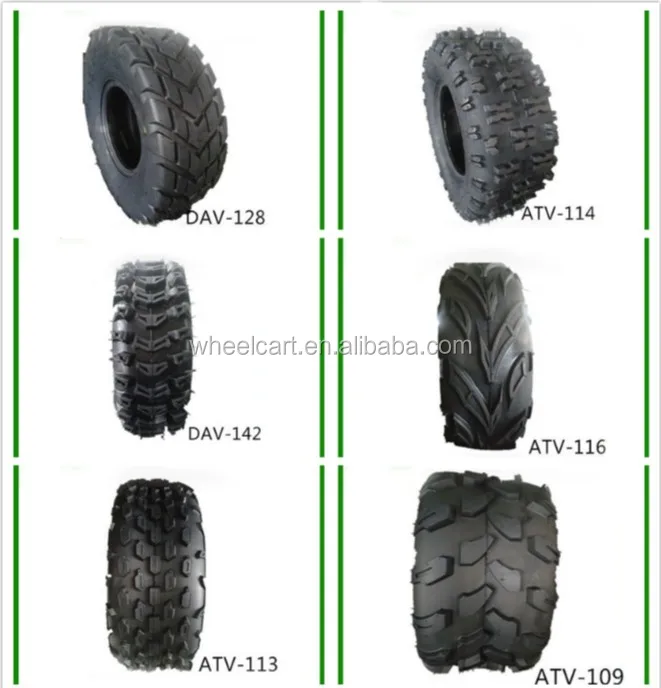 25×10-12 is 25″ tall). 3rd Number = The rim or wheel diameter (Ex. 25×10-12 is 12″ in diameter).
25×10-12 is 25″ tall). 3rd Number = The rim or wheel diameter (Ex. 25×10-12 is 12″ in diameter).
– 1st Number = The overall height of the tire. (ex. 25×8-12 tire is 25″ tall.)
– 2nd Number = The overall width of the tire. ( ex. 25×8-12 tire is 8″ wide)
– 3rd Number = The rim diameter. ( ex. 25×8-12 tires are designed to mount on a 12″ rim)
Rim Size P-Metric Size
——— ————-
16 Inch 285/75R16
305/70R16 12.2 inches
315/75R16 12.3 inches
345/75R16 13.6 inches
An important factor influencing the performance of an ATV is its tire type. Some riders change tires as soon as they buy them to meet all riding requirements. Other riders are faced with the need to buy new tires when the old one has worn out. But before buying, you need to figure out what qualities tires for an ATV should have.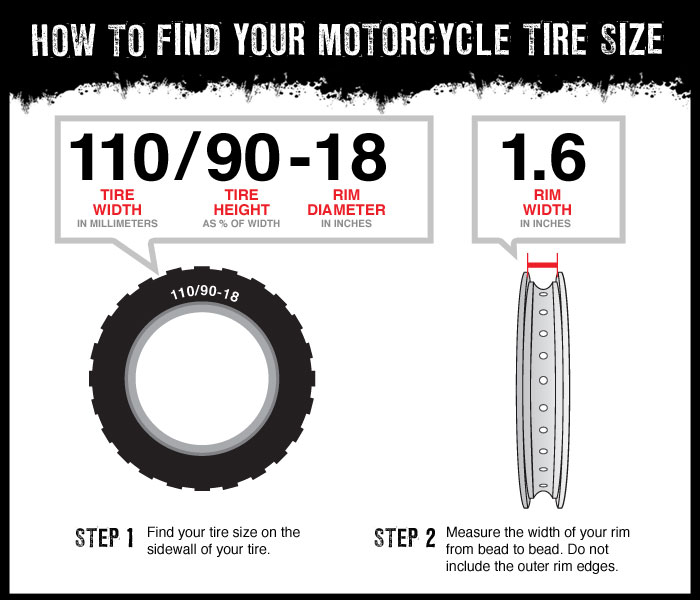
It is worth starting with the choice of wheel size. You can change the standard diameter by selecting the wheels in accordance with the driving style and features of the vehicle operation. At the same time, the technical characteristics of motor vehicles are also taken into account. The larger the diameter, the larger the contact patch of the tread with the road, the higher the off-road patency. The small size of the wheels allows you to develop high speed. At the same time, the cross-country ability of the ATV on the road is reduced.
When choosing a diameter, pay attention to the engine size. If it is not more than 50 cm³, you should not change the size of the wheels. Such ATVs lose their sensitivity and controllability after changing the standard size. There is a certain pattern to keep in mind when changing the diameter of the wheels: tires that are too large reduce the life of the engine, transmission and suspension, and also reduce torque.
ATV tires can be of two types:
• Diagonal.
• Radial.
It is worth noting that both types of tread pattern are designed for off-road driving. Diagonal varieties are in great demand, as they maintain high course stability when driving through mud or swamps, and make it easy to overcome obstacles on the road.
Radial tires give you more speed on hard surfaces. Most often, this type of tread pattern is found on racing ATV tires.
ATV tires feature a unique tread pattern. It directly depends on how the ATV will move over rough terrain. The drawing has characteristic features that determine the features of the operation of the vehicle. The following varieties are distinguished:
• For dirt. The pattern is deep, made in the form of a herringbone, which avoids slipping on a viscous or wet surface. The pattern on the front and rear tires is different. This is necessary in order to avoid slipping in the mud. The rear tires have a pattern in the form of deep grooves and side hooks. Mud tires are used primarily by farmers and the most extreme riders.
• For sand. The tread has special blades that perfectly remove loose soil from the contact spot area. This provides excellent tire grip on the road. Such a pattern looks like long blocks, which, like buckets, scoop up soft soil. Sand tires cannot be used for other surfaces, so their area of use is very limited.
• Sports. The flat surface of the tires has small lugs to keep the course stable on hard ground. Tires are made of soft rubber, which allows you to keep the course well. Flexibility provides a bi-directional pattern. To overcome obstacles well, sports tires have a strong shoulder area.
• Universal. The tread has a fine pattern that shows good grip on most types of road surface.
• For grass. When driving on grass, the tires evenly distribute the load in the contact patch. This ensures high stability and wear resistance. The protector has no lugs, which allows you to move around the lawns without causing them much damage.
• Winter. They are distinguished by the presence of a special pattern that complements the spikes or chains.
Tire pressure matters for flotation. It should not be too high so that the tires do not bounce strongly from bumps. This improves cross-country ability, which is especially important when driving over rough terrain. If you want to travel on a normal road, the tire pressure of the ATV should be increased.
Off-road tires are inflated to 0.35-0.83 bar. More pressure is required for riding on a hard track.
ATV markings contain many letters and numbers. To understand what information they provide to the buyer, it is required to consider the decoding of the marking.
So, if the rubber is used for off-road driving, the manufacturer puts the letters NHS on it. These tires are not designed to travel at high speed, so they can not be used on a normal road.
Tire parameters are usually measured in two different systems:
• Metric.
• English.
The metric system turned out to be more convenient for our customers. Although marking according to the English method also takes place. According to it, tire parameters can be written as follows: 25x8-12
The first number after the letters indicates the height of the tire in inches, and the second indicates the width of the tire. The last two letters are the designation for the radius of the disk. It is worth noting that ATV tires with a radius of 12 inches are mainly on sale.
The metric system looks like this: 205/80R12.
In this case, the tire size is indicated in millimeters, where the first number 205 is the width of the tire. The second number is the ratio of the profile height to the tire width. The letter R lights up that the tire is radial. The number that follows it indicates the diameter of the wheel. So, on sale you can find tires for an ATV R13 or R14.
The marking may also include a speed index. It is indicated by the letters of the Latin alphabet, for example, N, T, J, C. This indicator corresponds to the speed limit at which the tires can maintain good stability, performing the functions assigned to them.
So, for example, the letter C corresponds to a speed of 60 km / h, J - 100 km / h, N - 140 km / h, T - 190 km / h, etc. This limit cannot be exceeded, as the tires will lose their previous stability course.
Maxim Rogov / author of the article
Back in 2011, I got on a motorcycle for the first time and since then I have been addicted to motorsport. I love trying new bikes. I dream of a BMW F800GT and a motorcycle tour of Peru.
Moscow:
1st Varshavsky proezd, 2s8
+7 499 500-97-34 Call me back
RWD ATVs are not the best choice for tough off-road conditions like swamps and deep snow. This stamp has penetrated so deeply into the minds of compatriots that a compact ATV immediately becomes an outsider: well, what can you expect from it, it doesn’t go and shouldn’t! It is a paradox, but it is precisely this confidence in the helplessness of the "mono drive" that often becomes the reason for its low cross-country ability.
Of course, the off-road potential of an all-wheel drive vehicle is higher, however, a significant share of off-road success also depends on the pilot's experience. We will analyze off-road driving techniques another time, but today we’ll talk about how any off-road begins, about tire pressure.
Any experienced pilot, be it an ATV or a Jeep, starts off with a pressure check. After all, no matter how high the potential of technology is, and no matter how many off-road bells and whistles it has, all this does not matter as long as the pressure in the wheels does not correspond to the situation.
We all know that a pneumatic tire works like a balloon: when you inflate it to the limit, it becomes stiff, like a soccer ball. We blow it off, and the thin rubber, which until recently touched the surface with a place the size of a coin, literally spreads. The same applies to tires.
For riding on hard surfaces, such as dry dirt or asphalt, the pressure is usually increased - so the ATV reacts more sharply to steering turns, more stable at high speeds and in turns. But as soon as you move off the road, high pressure becomes an enemy: a small contact patch does not allow the rubber to enter a normal grip, and excessive wheel stiffness significantly reduces comfort.
At the same time, reducing pressure can increase tire grip and comfort by several times - a soft wheel will work out some of the bumps, helping the suspension and significantly improving not only flotation, but also ride smoothness. However, extremely low pressure is also a risk - the ATV becomes lower, and under heavy loads, especially on hard surfaces, the wheel can even be disassembled.
That is why, when choosing the right pressure, it is worth following the manufacturer's recommendations for . For example, YACOTA for its CABO 200 ATV recommends a pressure of 0.2 "atmosphere" in the front wheels and 0.1 in the rear , with which the ATV will feel as confident as possible on the roads. At the same time, for driving on hard surfaces, the pressure can be increased up to 0.5 "atmosphere".
To do this, you can purchase the most budgetary pressure gauge, or use a pump that already has a pressure gauge, of which there are a huge number on the market. The main thing is not to confuse the units of measurement in which the manufacturer indicates the pressure. There are two main systems in the world: the European Bar (newton per square meter), which we usually call "atmospheres", and the American PSI (pound force per square inch).
The PSI unit is equivalent to 0.068948 Bar, and often seeing the recommended pressure of 2.5 PSI is actually 0.1 Bar, and owners and even some sellers of ATVs, confusing these two different systems, pump 2.5 "atmospheres" into the wheels calculated for 0.5. Hence 80% of complaints about poor cross-country ability, low tire mileage, and lack of minimal comfort.
After checking the tires and setting the required pressure, you run the risk of not recognizing your ATV: the cross-country ability, especially in difficult conditions, will increase significantly, and the shaking, if it does not disappear completely, will be felt much less. In addition, "soft" wheels are much more difficult to puncture with a sharp stone or a dried branch, which means that most of the problems will simply disappear along with the excess air from the tires.